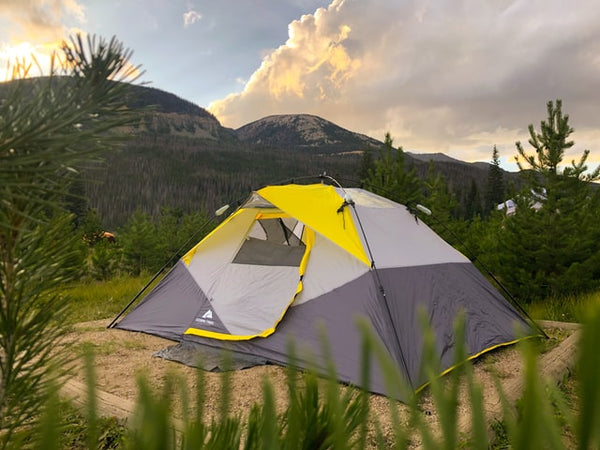With over 10,000 orders
With over 10,000 orders

You don't want the inside of your tent to be gross and smelly, do you? Then follow these tips on how to clean a tent and restore it to its former glory.
It's that time of year again when the weather is warming up and campers start preparing for their trips. And, if you're like most campers, you probably take your tent for granted. You set it up, spend a few days inside of it, and then take it down without ever giving it a second thought. But if you want your camping trips to be as pleasant as possible, it's important to keep your tent clean and in good condition. After all, a clean and well-maintained tent can keep you dry and comfortable - no matter what the weather throws at you.
Related: How to a tent for a camping?
In this blog post, we will discuss how to clean your tent and get it smelling fresh again. We'll also show you how to repair a tent quickly and easily so you can get back on the trails ASAP. Read on to learn more!

Photo by Syuhei Inoue on Unsplash
Here are some tips for cleaning a tent after you get home from the woods:
The first thing to do is unzip or open up your shelter, then take all of those dirty carpets out so they don't get mixed in with other fabric pieces—you'll know what I'm talking about if there's an obvious black residue on anything white! Once everything has been pulled apart enough (usually this involves just shaking off any dirt), spray down both sides halves of each panel with water/moisture cleaner and let sit overnight before wiping away excess liquid using either a sponge or dry rag.
The next day, wipe all of the seams down with a q-tip dipped in vinegar to help prevent any mildew growth and let the tent dry out in the sun for a few hours if possible. Finally, re-treat the waterproof/water repellant coating on your flysheet by spraying it with an aerosolized form of the substance. If there's pine sap or other hard-to-remove sticky spots, use a little bit of rubbing alcohol on a q-tip to help loosen it up before wiping away.
Mold makes people sick - so when taking care of any fabric surfaces in or on tents make sure there isn’t visible signs suggesting fungus growth by wiping down all areas with bleach solution before storing away for next time (or even if just drying). Be sure to avoid using any kind of petroleum-based products, as they will degrade the fabric over time. And don't forget to store your tent in a cool, dry place when you're not using it!

Photo by Ivan Rohovchenko on Unsplash
You should give your tent a thorough cleaning at least once a season, but more often if it's been subjected to particularly muddy or sandy conditions. A good rule of thumb is to clean your tent as soon as possible after each trip. This will help prevent any dirt or grime from building up and making it more difficult to clean later on.

Photo by Vlad Shalaginov on Unsplash
During your camping trip, you should take some time to sweep out your tent every day. This will help remove any dirt, dust, or leaves that have made their way into your shelter. You can use a small broom or dustpan for this task. It's also a good idea to wipe down the inside of your tent with a damp cloth every few days. This will help remove any sweat or body oils that have accumulated on the fabric. Be sure to let your tent dry completely before packing it up for the day.

Photo by Kevin Payan on Unsplash
Are you one of the lucky campers that have never had to worry about a torn tent? If so, count your blessings and know that repair is not difficult, just time-consuming. For the rest of us, here are some tips on how to repair a tent using some simple supplies that you may have on hand.
First, determine what caused the tear. Common culprits include wind, rain, and tree branches. Once you've identified the cause, take steps to prevent it from happening again. If it's a tear caused by wind or rain, try reinforcing weak spots with tape or sealant. If a branch was the problem, move your campsite next to taller trees. With these measures in place, you can now start repairing the tear itself.
The most common type of damage that tents experience is holes or tears in the fabric. These can be caused by sharp objects, like branches or rocks, coming into contact with the tent. If you find a hole or tear in your tent, the best way to repair it is with a piece of fabric adhesive tape. This type of tape comes in a variety of colors and can be found at most hardware stores. To use the fabric adhesive tape, simply clean the area around the hole or tear with a damp cloth. Then, cut a piece of tape that is slightly larger than the damaged area. Apply the tape to the fabric, being sure to smooth out any wrinkles or bubbles.
Another common type of damage that tents experience is broken poles. This type of damage is usually caused by high winds or by someone accidentally stepping on a pole. If you find that one of your tent poles is broken, the best way to repair it is with a splint. To make a splint, you will need two straight sticks that are about the same length as the broken pole. Place one of the sticks on either side of the break and then tie them together with some string or cord. Once the splint is in place, you can use it to support the broken pole until you are able to get a replacement.
Properly cleaning and repairing your tent is essential for maintaining a comfortable and safe camping experience. Be sure to give your tent a thorough cleaning at least once a season, and take some time to sweep it out and wipe it down every day during your trip. If you find any holes or tears in your tent, repair them with fabric adhesive tape. With a little bit of care and attention, your tent will be able to provide you with many years of comfortable camping!
Happy trails!
Hungry for more?
{"one"=>"Select 2 or 3 items to compare", "other"=>"{{ count }} of 3 items selected"}
Leave a comment